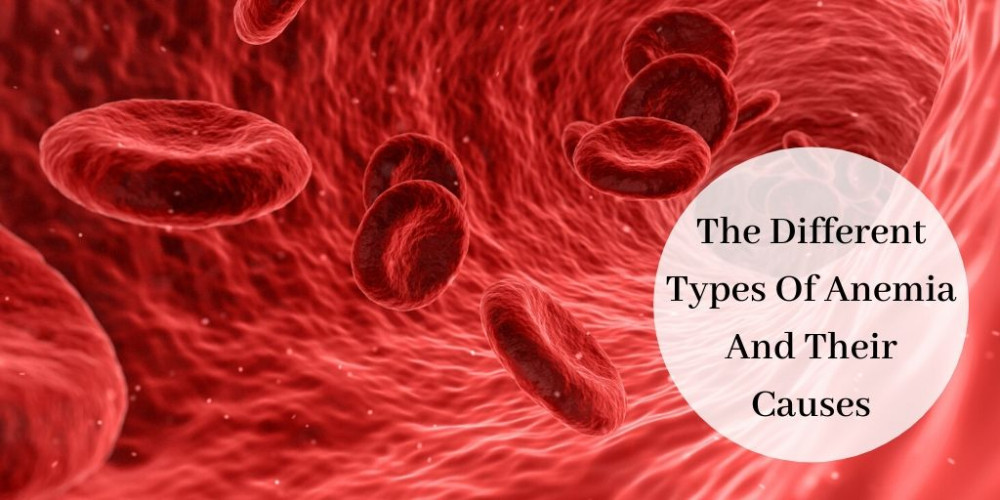Anemia is defined as having a low-oxygen carrying capacity in the blood. This is caused by either a decreased production of red blood cells or dysfunctional red blood cells, which are vital for delivering oxygen to tissues in the body. There isn’t just one kind of anemia, but several, with each being linked to certain conditions. Keep reading to learn about the different types of anemia and their causes.
Table of Contents
The Different Types Of Anemia
1. Iron Deficiency Anemia
Iron-deficiency anemia, the most common type of anemia, is caused by insufficient amounts of iron. Iron is necessary for the production of hemoglobin, a protein molecule in red blood cells (RBCs) which transports oxygen throughout the body. A deficiency of iron leads to low heme, an organic compound that iron atoms attach to, which leads to low levels of hemoglobin. Not surprisingly, iron supplementation is used to treat iron-deficiency anemia.
Causes include an insufficient intake of iron in the diet or a reduced ability to absorb the iron in food that’s consumed. A regular intake of iron-containing foods, including eggs, meat, seafood, dried fruit, leafy green vegetables, and iron-fortified foods, can prevent anemia. Supplementing with vitamin C at meals aids in the absorption of iron. Certain conditions, such as Celiac disease, leaky gut, and Crohn’s disease are risk factors for anemia because they can prevent iron from being absorbed.
Causes and Risk Factors
Blood loss can cause iron-deficiency anemia because iron is contained within blood. I can personally attest to this as I hemorrhaged following the birth of one of my children, which left me extremely anemic for months afterwards even though I had received blood transfusions. Heavy menstruation is another risk factor for anemia, as is prolonged chronic blood loss caused by hiatal hernias, ulcers, polyps in the colon, and colon cancer.
Pregnancy is a risk factor for low iron, as well, due to the increase in blood volume that occurs during pregnancy, along with the growing needs of a fetus. This is why prenatal vitamins contain iron. People who frequently donate blood, menstruating women, infants who are born prematurely, and vegetarians are all at increased risk for developing iron-deficiency anemia.
Mild forms of anemia generally don’t cause complications, however more severe forms can lead to growth problems in children, low-birth weight babies, and cardiovascular problems. This is because the heart has to pump more and more blood due to the lack of oxygen contained within it. Click the link below if you suspect you could be anemic.
Check your iron levels here
2. Pernicious Anemia
Pernicious anemia is caused by a lack of red blood cells due to insufficient absorption of folate (B9) and vitamin B12. Impaired uptake of these nutrients prevents the production of healthy red blood cells, which are needed to carry oxygen throughout the body. People who can’t properly absorb B vitamins, or who lack the nutrients in their diet, are at higher risk for developing pernicious anemia.
The stomach lining produces a substance called intrinsic factor, which is necessary for B12 absorption. Pernicious anemia develops if the parietal cells within the stomach can’t make intrinsic factor. Parietal-cell destruction can be caused by an autoimmune attack, in which the immune system attacks its own tissues, in this case the parietal cells.
Pernicious anemia, if not diagnosed and treated, can cause permanent nerve and organ damage, and is a risk factor for stomach cancer. Peripheral neuropathy, weakness, exhaustion, confusion, an unsteady gait, and a bright red tongue are all symptoms of anemia. A vitamin B12 deficiency can mimic the symptoms of multiple sclerosis, namely peripheral neuropathy, which is numbness and tingling in the hands and feet,
Diagnosis and Risk Factors
Diagnosis is made by taking a comprehensive medical history, along with physical exams and diagnostic testing procedures. Blood testing is used to measure levels of B12, iron, and intrinsic factor in the blood. Antibodies against intrinsic factor can also be measured to confirm or rule out autoimmunity.
Click here to measure B12, iron and intrinsic factor
Click here for antibody testing
Risk factors include being of Scandinavian or Northern European descent, having an existing autoimmune disease, a family history of pernicious anemia, being over 60 years of age, and having had portions of the intestines or stomach removed. My great grandfather, who was of Danish descent, died of pernicious anemia when he was in his 40s. The disease used to be fatal.
Fortunately, pernicious anemia is rare and can be successfully treated using B12 supplements or injections given on a regular basis. Serious long-term effects can occur if the condition is not appropriately treated, including gastric cancer, nerve damage, neurological problems, and damage to the heart. These effects can be permanent, which underscores the importance of early diagnosis and treatment.
3. Aplastic Anemia
Anemia is caused by a reduced number of RBCs. Aplastic anemia, also called bone marrow failure, is not only a condition of low red blood cells, but also causes low levels of white blood cells (WHCs) and platelets. This is the result of damage to the bone marrow where these cells are produced. Aplastic anemia is an autoimmune condition in which the immune system attacks the stem cells in the bone marrow.
When stem cells are damaged, production of all three types of cells can be either halted or reduced, which causes low oxygen levels in the blood, along with a reduced infection-fighting capacity and impaired blood clotting. Easy bruising, fevers, and frequent infections are common symptoms. Symptoms vary from person to person, depending on the severity of the disease. Young adults and people over 60 are at increased risk for developing aplastic anemia.
The condition is rare, only four people out of every million will get aplastic anemia, which can be difficult to diagnose due to the similarity in symptoms to other diseases. The exact cause of the disease is unknown, but can be triggered by numerous factors, including exposure to radiation, chemotherapy, specific viral infections, certain medications, ionizing radiation, benzene, and pesticides. Toxin exposure can stimulate an autoimmune attack on the bone marrow.
Risk Factors and Treatment
Since radiation and chemotherapy can trigger the disease, people undergoing conventional cancer treatments carry an increased risk of developing aplastic anemia, as do people who have diseased or damaged bone marrow. The condition can develop slowly over time, presenting with mild symptoms, or develop suddenly with more severe symptoms. Over time, low blood cell counts can lead to blood disorders, bleeding, leukemia, and even heart failure.
Diagnostic tests include serum testing to measure blood cell counts in the blood and bone marrow. Bone marrow transplants, blood transfusions, and immune-suppressing medications are used to treat the disease. Necessary precautions are implemented to prevent infections if medications that suppress immune function are used. Lifestyle changes can help reduce exposure to toxins.
Hemolytic Anemia
Red blood cells live for approximately 120 days before being replaced via a process called hemolysis. Hemolytic anemia develops when RBCs are destroyed faster than they can be replaced. There are two types of hemolytic anemia: acquired and inherited. Acquired hemolytic anemia develops when normal red blood cells are destroyed. It is an acquired condition that develops over time, rather than an inherited one. It can be triggered by certain medications, bacterial or viral infections, cancers of the blood or autoimmune diseases.

Inherited hemolytic anemia develops as a result of genetic factors that regulate RBCs, and can be caused by sickle cell anemia or thalassemia. Both conditions are characterized by the production of red blood cells that have shorter lifespans than do normal RBCs.
Chronic lymphocytic leukemia and non-Hodgkin’s lymphoma can trigger an autoimmune form of hemolytic anemia (AIHA), in which the immune system mistakenly attacks the RBCs.
Autoimmune diseases, such as lupus, and viruses, including Epstein-Barr, HIV, hepatitis, and cytomegalovirus are also implicated. Medications like penicillin can also trigger an attack.
Diagnosis and Treatment
Tumors, an overactive spleen, negative reactions to blood transfusions, and having a mechanical heart valve are all risk factors for developing hemolytic anemia. The condition can be either chronic or temporary. Common symptoms include, jaundice, dark-colored urine, and an enlarged spleen.
Complete CBC blood counts, and other testing methods that measure RBCs, hemoglobin, antibodies, and hematocrit levels, are used to diagnose the disease. Urine testing is also used to shed light on iron and hemoglobin levels. Biopsies and bone marrow aspirations are used to determine the amount, size, and maturity of blood cells. During a bone marrow aspiration, fluid is taken from the bone marrow, whereas solid tissue is taken during a biopsy.
Complete CBC blood count
Treatment depends on a variety of factors, such as the cause of the disease, the individual’s reactions to specific medications and therapies, along with the overall health and medical history of the person. Treatment options include corticosteroid medications, surgery to remove the spleen, immunosuppressive therapy, immune globulin IVs, and blood transfusions. A medication called rituximab may also be used. If an autoimmune disease is present, it will be treated before the hemolytic anemia.
Symptoms Of Anemia
Symptoms tend to be similar with all types of anemia and include:
- Shortness of breath
- Fatigue
- Tachycardia
- Dizziness
- Cold hands and feet
- Brittle nails
- Pale skin
- Headaches
- Lightheadedness
- Leg cramps
- Increased thirst
Key Points
There are several types of anemia, each characterized by its own set of risk factors and causes. A low-oxygen carrying capacity in the blood, due to a lack of RBCs, can cause fatigue, weakness, and other symptoms.
Iron-deficiency anemia is caused by low levels of iron, pernicious anemia is an autoimmune condition related to B12 deficiency, aplastic anemia occurs from damage to the bone marrow, and hemolytic anemia is the result of red blood cells being destroyed faster than they can be produced.
Have you heard of these types of anemia? Let me know in the comments:)
References:
(1) Mayo Clinic: Iron deficiency anemia
(2) NHI.gov: Your Guide to Anemia
(3) MedicineNet: Pernicious Anemia and Vitamin B-12 Deficiency
(4) healthline: Pernicious Anemia
(5) NIH: Aplastic Anemia & Myelodysplastic Syndromes
(6) NIH: Aplastic Anemia
(7) John Hopkins Medicine: Hemolytic Anemia
(8) WebMD: Acquired Autoimmune Hemolytic Anemia
Disclaimer: This article is strictly for informational purposes only and is not intended to be medical advice. Please be diligent and always do your own research in regard to any material I present on this site. I claim no responsibility for any distress, whether it be physical or emotional, that may occur as a result of the information you obtain from my blog.




Hi There,
I regard cancer websites to be knowledgeable just like yours and it’s a hard thing to read as my mom has a tumor and has just started radiotherapy to fight against something that has changed her life from being an active lady to a wheelchair-bound person. Your website has some really important information that I enjoyed reading and there were even some snippets of beating cancer which helped me.
Steve
Hi Steve,
Thank you. I’m so very sorry to hear about your mom and how her life has changed. Cancer seems to do just that. I’m glad you found some valuable information on my site. Best of luck to you and your mom.
This is a really good one. I want to first commend your input of time and energy into making this awesome website with nice templates, and finding the time to write an article on the different types of anemia and their causes. Seeing the video made me realize that we actually take some things for granted.
Thank you. I appreciate you saying that. Anemia is an interesting subject because there are several different kinds, which ca be confusing to many people. Yes, I think it’s ingrained in human nature to take things for granted. Unfortunately. Awareness and appreciation are key!